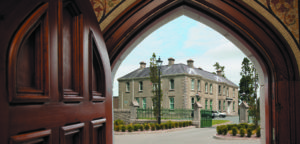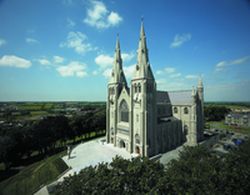CHURCH OF THE NATIVITY OF OUR LADY, ARDEE
HOMILY GIVEN BY
CARDINAL SEÁN BRADY
5 JULY 2008
Paul says:
‘We always give thanks to God, the Father of our Lord Jesus Christ, when we pray for you. For we have heard of your faith in Christ Jesus and of your love for all God’s people. When the true message, the good news first came to you, you heard about the hope which it offers. So your faith and your love are based on what you hope for, which is kept safe for you in heaven……….and with joy, give thanks to the Father who has made you fit to have your share of what God has reserved for his people in the Kingdom of Light’.
When I pray for my family, as I often do, those words regularly come into my mind. ‘We always give thanks to God the Father of our Lord Jesus Christ, when we pray for you.’ I pray with great affection for my family especially when I think of the sacrifices they have made, and continue to make for me. Then I realise that I belong to several families. I owe a lot to each one of them – the family of my parish, my diocese and my school. Then I think of all the families of religious orders which I have met and known. Among these, the family of the Sisters of Mercy must hold pride of place. For as I reflected on the theme of this Mass I came to realise that in every decade of my life I have owed a huge amount to the Sisters of Mercy.
Sixty years ago I first met them in the Surgical Hospital in Cavan when my father was a patient there. We all knew that in the loving care of the Sisters all his needs, spiritual and physical, would be met. In the fifties I was a patient there myself and experienced that same attention first hand.
In the nineteen sixties it was my privilege to say Mass in St Felim’s Hospital and
St Joseph’s Hospital, Cavan and to experience the love and care which the Sisters lavished so generously on those in their care regardless of whether they were rich or poor. In the eighties I met the late Sister Angela Bolster, in Rome, who was researching the life of the founder, the venerable Catherine McAuley, and preparing the documentation outlining the virtues and merits of that Holy Woman, with a view to her beatification. That work has not yet borne fruit but we should continue to hope and above all, to pray that it will take place.
Finally in the nineties and in this decade, it was my given joy to discover the Sisters of Mercy in this diocese in Cookstown, Dungannon and Bessbrook, Dundalk and Ardee. I come to realise the treasure they are.
And so here we are today, in Ardee, to give thanks for your presence in Ardee over the last 150 years. As we do so we concentrate on what you are rather than what you do, not on the contribution which you have made and continue to make to society. Yes, of course, the latter are immensely valuable. But the most important thing of all is the kind of people you are. You are people who, when the Spirit called you by name, you were not afraid to say yes. At times it may have seemed as if you were passing through the sea or through rivers and yet you were not swallowed up for you are following Christ. You discovered that you were precious in his eyes.
At times it may indeed have seemed as if you were passing through fire and yet you were not scorched because you got the freedom and the strength to dedicate yourself totally to God; a God whom you loved supremely and by whom you knew for certain you were loved in return. In that love you discovered that the love of Christ was true love, a love that never fades or lets you down. There you got the patience and the confidence to dedicate yourselves to seek that perfect love. It is a perfect love because it is built on four solid foundations. It is a love that is not in the service of oneself, it is a love dedicated to the service of others for the sake of the Kingdom of Heaven. You undertook this life for the honour of God there can be no greater call than that for the honour and glory of God. You have given your lives to the building of the Church, the building of the Body of Christ in order to save people. You have built up the Body of Christ with your prayer and your sacrifices, with your faith and your love, with your teaching and your nursing and above all, with your love for the poor.
The result is that you are a splendid sign in the Church; a splendid sign to the rest of us. A sign of what you may ask? A sign of the Glory of Heaven to which we are all called but a call which too often we ignore.
Last week I was in the Servite Priory, Benburb to celebrate to end of their Chapter and the 750th anniversary of the foundation of their Order. Something that has survived for almost eight hundred years surely has something going for it. A lot going for it as do you, the Sisters of Mercy. All of you are splendid signs in the Church because you foretell the Glory of Heaven. We all need these signs to remind us and to redirect us just as we need signposts on the journey of life to head us in the right direction.
Last week I was down in Clonmel to celebrate the Beatification of Antonio Rosmini founder of the Rosminian Order. It took place last November in Novara in Italy. When Rosmini died he left a spiritual legacy to the Italian writer Manzoni. It consisted of three words:
Adore
Be Silent
Rejoice.
On the way down I visited a house of Edmund Ignatius Rice, the house where he was born. I saw there the text of his vows and the vows of all Christian Brothers. They began with these words:
‘In profound adoration before thy infinite and adorable majesty I concentrate myself to thee in order to procure thy glory.’
I was struck by the fact that in the lives of both of these, now blessed people, Antonio Rosmini and Edmund Ignatius Rice the idea of adoration was central. They realised that we are placed on this earth to give praise and glory and adoration to the God who created us, the God on whom we depended every moment, the God with whom we hope to be happy forever in everlasting glory and that is what we are celebrating here today. The fact is that you are this splendid sign of this glory.
It all goes back to your eminent Foundress Catherine McAuley. Like the apostle Thomas, Catherine McAuley had her faith strengthened immensely by her contact with the wounds of the Body of Christ in the form of her helping the poor of Dublin. Her faith was also strengthened through lots of trials which she had to endure in order to preserve her faith when it was under attack. That same faith gave her a tremendous sense of the presence of God. Her faith urged her to build a house for the glory and honour of God and her own faith was the corner stone of her House of Mercy. From this followed the fact that prayer was her delight and refuge in all trials. Shortly before her death she remarked to Sister Aloysius Scott ‘Prayer will do more than all the money in the Bank of Ireland.’ It is prayer that was centred on Christ. For Catherine McAuley, outside of Christ there was nothing. She once said ‘The humbled, abandoned, agonising Christ: this is my Christ. Him will I have and hold. Outside of him – nothing.’
Once when she was deprived of all outward aids, she was able to discern the cross in the panels of her bedroom window and in the intersecting branches of the trees. So she had a very deep devotion to the passion and to the death of Christ our Saviour.
Catherine McAuley’s vision of service in mercy was an expression of her love for God. At Easter 1841, the year of her death, she identified mercy as the bond of union and God’s great gift to her congregation when she said ‘The blessing of unity still dwells among us, and oh, what a blessing. This is the spirit of the Order, indeed the true spirit of mercy flowing in us, that notwithstanding our own unworthiness God never seems to visit us with an angry punishment.’
Her love of God expressed itself in charity towards all. It was an inclusive love especially towards the poor with whom she identified, and towards her Sisters in religion. Her charity towards the poor was seen in many ways. In them she recognised and saw God. She once said ‘It is for God we serve the poor, and not for thanks.’ Her sensitivity towards the poor was outstanding. She once said ‘There are things which the poor prize more highly than gold, though they cost the donor nothing. Among these are the kind word, the gentle compassionate look and the patient gain of sorrows.’ In her special vow formula Catherine included the words ‘The service of the poor, sick and ignorant.’
Her concern for unemployed young women, rejected by an unkind society, was outstanding. It was for them she opened her House of Mercy. Her compassion for orphans and children otherwise neglected and deprived and her sympathetic care of other neglected persons who required nursing care are indications of this immense charity towards the poor. She trusted all who came to her for assistance and once said ‘It is better to relieve one hundred imposters if there be any such, than to suffer one really distressed person to be sent away empty.’
For all of this we give thanks today. We pray that the Spirit of Mercy may long continue to flourish not only here in Ardee but among the Sisters of Mercy everywhere.
In the Old Testament God is seen as a God who responds to the suffering and need of those who fought to live. God is a helper who gives people hope. In the New Testament Jesus sees his mission as one of compassion and healing of suffering. He is ready to acknowledge the needs of the poor and the politically oppressed. He shows sympathy for the social outcasts, for the weak and the abandoned. He brings forgiveness to those who repent, healing to the sick in mind and body, consolation to the sad and sorrowful and patience towards those who of violence.
It is a hard act to follow. But today we thank God for the mercy of so many people in this house over the past 150 years. The Spirit of Mercy nourished on the body and blood of the new covenant, supported by the Risen Christ in prayer and sacrifice.
AMEN



 The Archbishop of Armagh, Cardinal Seán Brady, announces the following clergy appointments, which are effective from Tuesday 1 July, 2008.
The Archbishop of Armagh, Cardinal Seán Brady, announces the following clergy appointments, which are effective from Tuesday 1 July, 2008.
You must be logged in to post a comment.